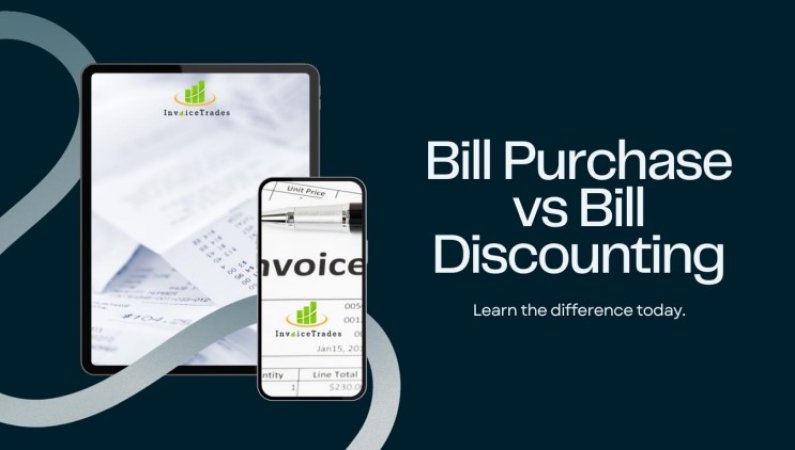
In the complex world of trade and commerce, financial instruments play a crucial role in facilitating transactions and ensuring smooth business operations. Two such instruments, Bill Purchasing and Bill Discounting, are often employed to address liquidity needs and optimize cash flow. In this blog post, we will delve into the intricacies of these financial mechanisms, exploring their definitions, purposes, and the key differences that set them apart.
Bill purchasing is a financial transaction where a party, often a financial institution or a third-party entity, outright buys a trade bill from the original holder. In this arrangement, the purchaser becomes the new owner of the bill, assuming both control and credit risk. The primary purpose of bill purchasing is to provide immediate liquidity to the bill holder, enabling them to access funds tied up in outstanding bills before the maturity date.
Bill discounting, on the other hand, involves the advance payment of the bill amount by a financial institution, while the original holder retains ownership. The discounting entity, typically a bank, provides an immediate cash advance to the bill holder, with the discounted amount reflecting the interest on the advanced sum. Bill discounting serves a similar purpose as bill purchasing—offering quick access to funds before the bill matures.
In bill purchasing, the transaction concludes with the outright purchase of the bill, making the purchaser the new owner. In contrast, bill discounting results in an advance payment to the original holder, who retains ownership of the bill. This distinction is crucial in understanding the dynamics of control and responsibility in each scenario.
Bill purchasing transfers outright ownership to the purchaser, meaning they assume both control and credit risk associated with the bill. On the contrary, bill discounting allows the original holder to maintain ownership, while the discounting entity holds a claim on the bill amount. The original holder remains responsible for bill collection.
In bill purchasing, the purchaser bears the credit risk and is responsible for collecting the bill amount. Conversely, in bill discounting, the discounting entity assumes credit risk only if the bill is dishonoured, and the original holder retains the responsibility for bill collection.
Bill purchasing provides the purchaser with complete control over the bill, allowing them to enforce terms and conditions. In bill discounting, the original holder retains control, and the discounting entity has a limited say in bill enforcement.
The cost implications of these two mechanisms differ significantly. Bill purchasing typically involves a higher cost, as it reflects the outright purchase of the bill. In contrast, bill discounting costs are relatively lower, as they primarily encompass the interest on the advanced amount.
While bill purchasing and bill discounting have distinct characteristics, they share some commonalities. Both financial instruments involve trade bills and aim to provide liquidity to the bill holder. Additionally, they are prevalent in the realm of business and trade financing, contributing to the efficient management of cash flow in various industries.
In conclusion, understanding the nuances between bill purchasing and bill discounting is crucial for businesses seeking to optimize their financial strategies. The decision to choose one over the other depends on the specific needs and preferences of the entities involved. By weighing the advantages and disadvantages of each mechanism, businesses can make informed decisions that align with their financial goals and objectives. Whether outright ownership and control in bill purchasing or maintaining ownership and accessing immediate funds in bill discounting, these financial instruments play pivotal roles in shaping the financial landscape of modern trade and commerce.
A: Bill purchasing and bill discounting are financial transactions aimed at providing immediate liquidity to businesses. Bill purchasing involves the outright purchase of a bill, while bill discounting allows the holder to receive an advance payment on the bill amount.
A: In bill purchasing, the purchaser becomes the outright owner of the bill, assuming credit risk and responsibility for collection. In bill discounting, the original holder retains ownership, and a financial institution provides an advance payment, holding a claim on the bill amount.
A: Both bill purchasing and bill discounting typically involve bills of exchange and promissory notes. These financial instruments are used in trade and commerce to facilitate transactions and credit arrangements.
A: In bill purchasing, there are usually a seller (original holder) and a purchaser. In bill discounting, the original holder, a financial institution, and potentially the payer of the bill are the main parties.
A: In bill purchasing, the purchaser assumes credit risk, while in bill discounting, the risk is transferred to the financial institution only if the bill is dishonoured. The original holder is typically responsible for bill collection in both cases.
A: In bill purchasing, the purchaser has complete control over the bill and can enforce terms and conditions independently. In bill discounting, the original holder retains control, and the discounting entity has a limited say in bill enforcement.
A: Bill purchasing usually involves a higher cost as it reflects the outright purchase, with the purchaser bearing the full cost. Bill discounting has a lower cost, representing the interest on the advanced amount, and the original holder bears the cost of the discount.
A: Yes, both methods are widely used in business and trade financing to enhance cash flow, manage working capital, and provide flexibility in financial transactions.
A: Bill purchasing and bill discounting offer businesses the flexibility to manage their cash flow effectively by providing access to funds tied up in accounts receivable. This can be crucial for meeting operational expenses and seizing new business opportunities.
A: Considerations include the cost of financing, the level of control desired over the bill, credit risk tolerance, and the specific financial goals and circumstances of the business. Each method has its advantages, and the choice depends on the unique needs of the business.